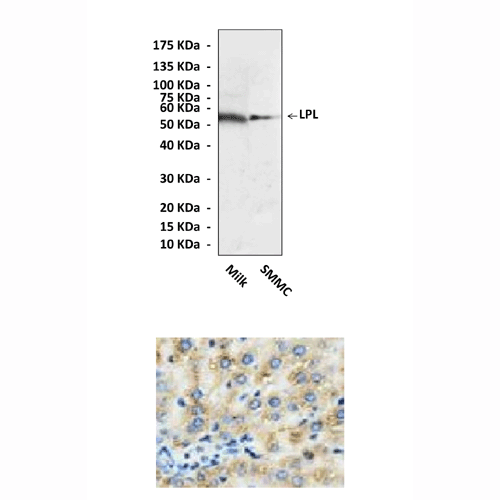Anti-LPL: Polyclonal Lipoprotein Lipase Antibody
Price: $0.00
Description
It has also documented premature atherosclerosis, elevated triglyceride-rich lipoproteins, and reduced HDL-C in people with moderately reduced LPL activity caused by LPL mutations. Overexpression of LPL in transgenic mice reduced plasma triglycerides and increased high-density lipoprotein cholesterol (HDL-C) concentration, prevented hypertriglyceridemia after a high-fat or high-sucrose diet, and blunted the lipoprotein disorders associated with diabetes. In addition, overexpression of LPL, specifically in skeletal muscle, was sufficient to impart resistance to diet-induced obesity. A rapid catabolism of HDL apolipoprotein and decreased HDL-C was observed in primates after acute injection of an antibody against LPL. There are many factors that can regulate expression of LPL. It was demonstrated that local contractile activity is required for increasing LPL expression during exercise training and for maintaining a high level of LPL expression in postural muscles.2 However, all-trans retinoic acid (RA) can specifically down-regulate LPL enzyme expression in adipocytes at the posttranscriptional level.3
2. Hamilton, M.T. et al: Am J Physiol Endocrinol Metab 275: E1016-E1022, 1998
3. Kamei, Y. et al: Biochem. Int. 26:923-34, 1992
Details
| Cat.No.: | CA1787 |
| Antigen: | C-terminus |
| Isotype: | Affinity-Purified Rabbit Polyclonal IgG |
| Species & predicted species cross- reactivity ( ): | Human, Rat |
| Applications & Suggested starting dilutions:* | WB 1:500 to 1:1000 IP n/d IHC (Paraffin) 1:50 to 1:200 ICC n/d FACS n/d |
| Predicted Molecular Weight of protein: | 55 kDa |
| Specificity/Sensitivity: | Reacts specifically with LPL of human & rat origin in immunostaining and Western blot applications. |
| Storage: | Store at 4° C for frequent use; at -20° C for at least one year. |
*Optimal working dilutions must be determined by end user.




